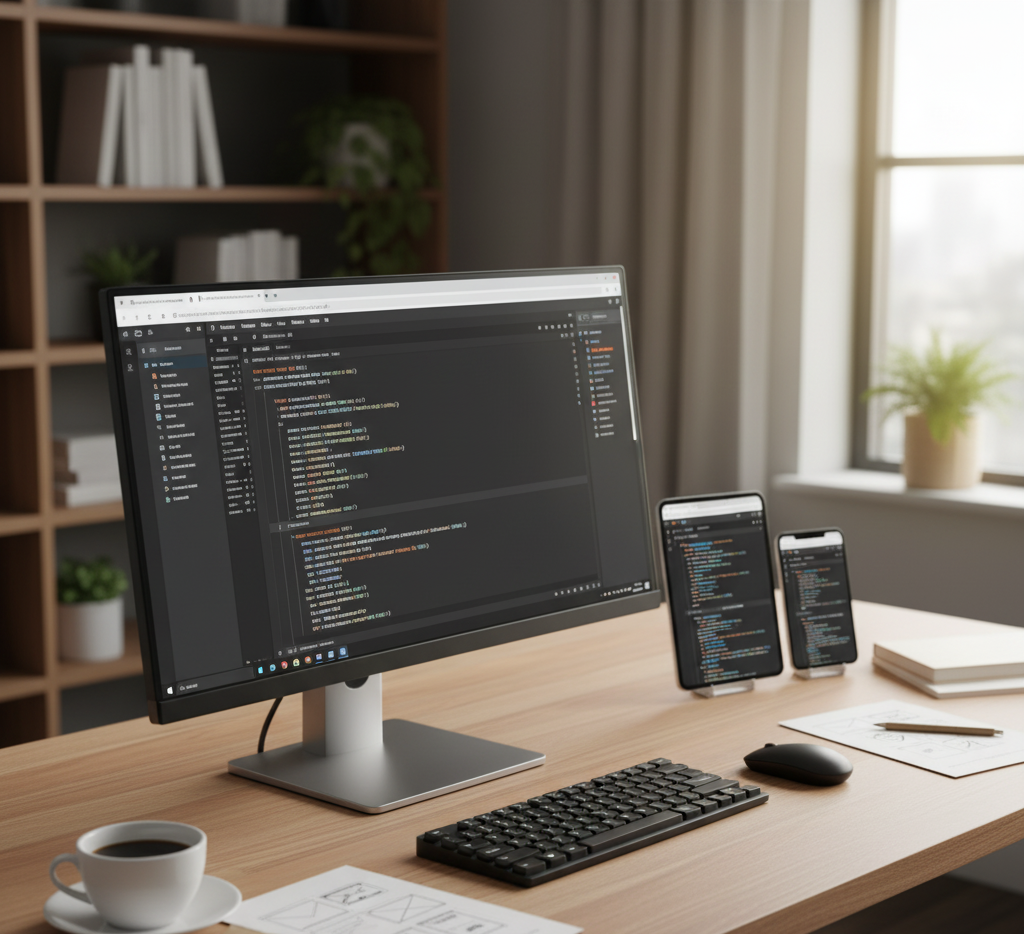Building responsive interfaces today isn’t just about resizing elements — it’s about crafting adaptive experiences that look perfect on every screen. Tailwind CSS has completely transformed how developers approach responsive design by combining flexibility, performance, and design consistency.
Let’s explore how to create stunning, responsive UIs using Tailwind CSS with real-world strategies, best practices, and one powerful design hack to take your layouts to the next level.
Why Tailwind CSS Dominates Modern UI Development
Tailwind CSS stands out because it embraces utility-first design. Instead of writing endless CSS classes or components, you work directly with utility classes that describe the final design outcome.
This approach makes your code more maintainable, consistent, and scalable — which is exactly what modern web development requires.
Key advantages:
- Instant responsiveness with mobile-first utilities (
sm:,md:,lg:) - Automatic dark mode compatibility
- Built-in design consistency
- Faster development and fewer CSS files
Understanding Responsive Design in Tailwind
Tailwind uses a mobile-first approach. This means that your default styles target mobile devices first, and then you progressively enhance them for larger screens.
Example:
<div class="text-base md:text-lg lg:text-xl">
Responsive text size with Tailwind
</div>- On mobile:
text-base - On tablet:
md:text-lg - On desktop:
lg:text-xl
This makes it effortless to create interfaces that scale naturally with device size — no extra media queries required.
Breakpoints That Matter
Tailwind provides intuitive default breakpoints that fit most modern devices:
- sm (640px) – Mobile
- md (768px) – Tablet
- lg (1024px) – Laptop
- xl (1280px) – Desktop
- 2xl (1536px) – Large screens
You can easily customize breakpoints in tailwind.config.js to match your specific design requirements.
Structuring a Responsive Layout
The grid and flex utilities in Tailwind make creating adaptive layouts incredibly easy.
Example of a responsive card layout:
<div class="grid grid-cols-1 sm:grid-cols-2 lg:grid-cols-3 gap-6">
<div class="p-4 bg-white dark:bg-gray-800 rounded-xl shadow-md">Card 1</div>
<div class="p-4 bg-white dark:bg-gray-800 rounded-xl shadow-md">Card 2</div>
<div class="p-4 bg-white dark:bg-gray-800 rounded-xl shadow-md">Card 3</div>
</div>✅ On mobile — 1 column
✅ On tablet — 2 columns
✅ On desktop — 3 columns
This fluid responsiveness eliminates the need for writing complex media queries while maintaining a clean and readable structure.
Using Dark Mode the Smart Way
Tailwind makes supporting dark mode effortless. You just need to enable it in your config and prefix styles with dark:.
<div class="bg-white dark:bg-gray-900 text-gray-900 dark:text-gray-100">
Responsive dark mode design with Tailwind
</div>This ensures your UI automatically adapts to the user’s system preferences — an essential accessibility and UX enhancement in 2025.
Responsive Typography and Spacing
Tailwind provides complete control over spacing, font sizes, and line heights with responsive prefixes.
Example:
<h1 class="text-2xl md:text-4xl lg:text-5xl font-bold leading-tight">
Responsive headline
</h1>his helps maintain proportional balance and readability across all devices — without switching files or overriding CSS.
Performance Optimization with Tailwind
One common misconception about Tailwind is that it bloats your CSS. The truth: it doesn’t — if you configure it correctly.
Use PurgeCSS (built into Tailwind) to remove unused classes in production:
module.exports = {
content: ["./src/**/*.{html,js}"],
theme: { extend: {} },
plugins: [],
}This setup ensures your CSS file stays extremely lightweight — often under 10KB, even for large projects.
Accessibility and UX Enhancements
Modern responsive UIs aren’t only about design — they’re also about usability.
Best practices:
- Use semantic HTML for screen readers.
- Maintain sufficient color contrast.
- Ensure tap targets are large enough on mobile devices.
- Test with keyboard navigation.
With Tailwind, you can quickly adjust spacing and contrast without modifying the entire stylesheet.
Lifehack: The “Container Query Trick”
One of the newest and most effective responsive design hacks: simulate container queries using Tailwind’s group and peer utilities.
Example:
<div class="group max-w-md hover:max-w-lg transition-all">
<img src="image.jpg" class="w-full group-hover:opacity-90" />
<p class="text-sm group-hover:text-base transition-all">
Adaptive layout with Tailwind
</p>
</div>This technique lets you create component-level responsiveness without depending on screen size — ideal for modular UI systems or reusable components.
Testing Your Responsive Design
After building your UI, test it on different devices and orientations. Tools like:
- Chrome DevTools (Device Toolbar)
- Responsively App
- Polypane
can save hours by simulating breakpoints and detecting design inconsistencies.
Final Thoughts
Creating responsive UIs with Tailwind CSS allows you to work smarter, not harder.
By embracing a mobile-first mindset, leveraging utility classes, and optimizing your performance setup, you can build interfaces that feel natural on any device — all while writing minimal CSS.


Leave a Reply